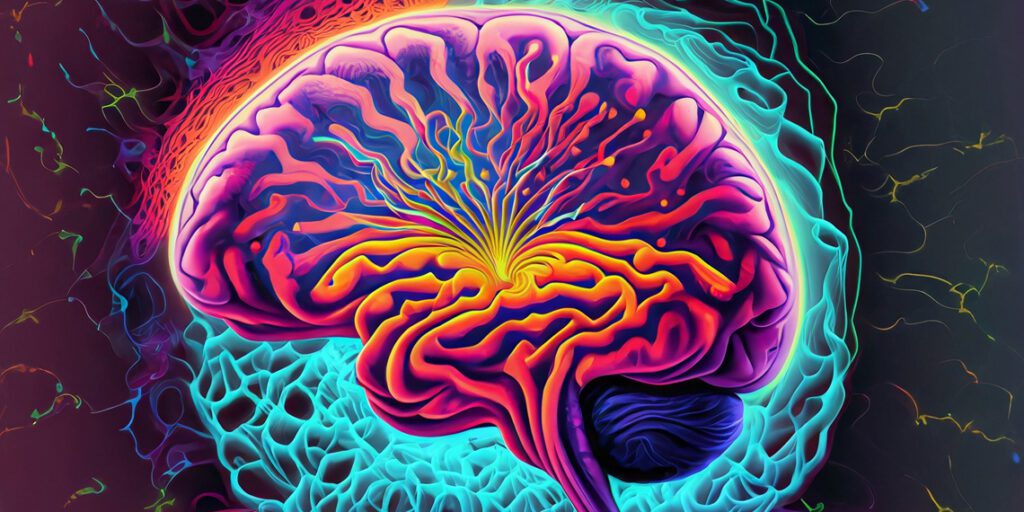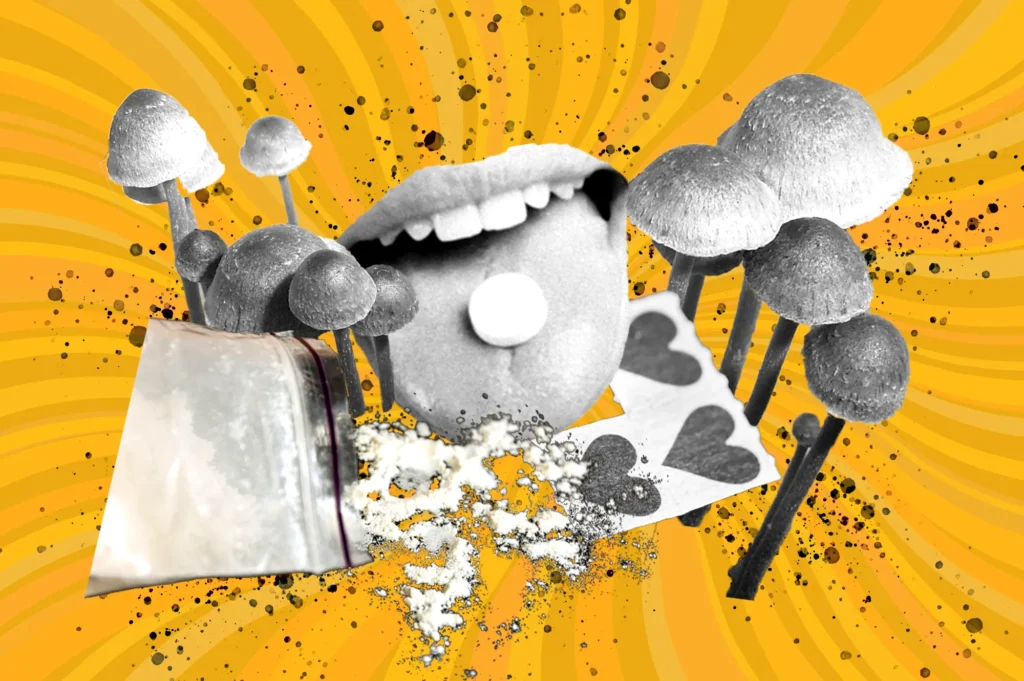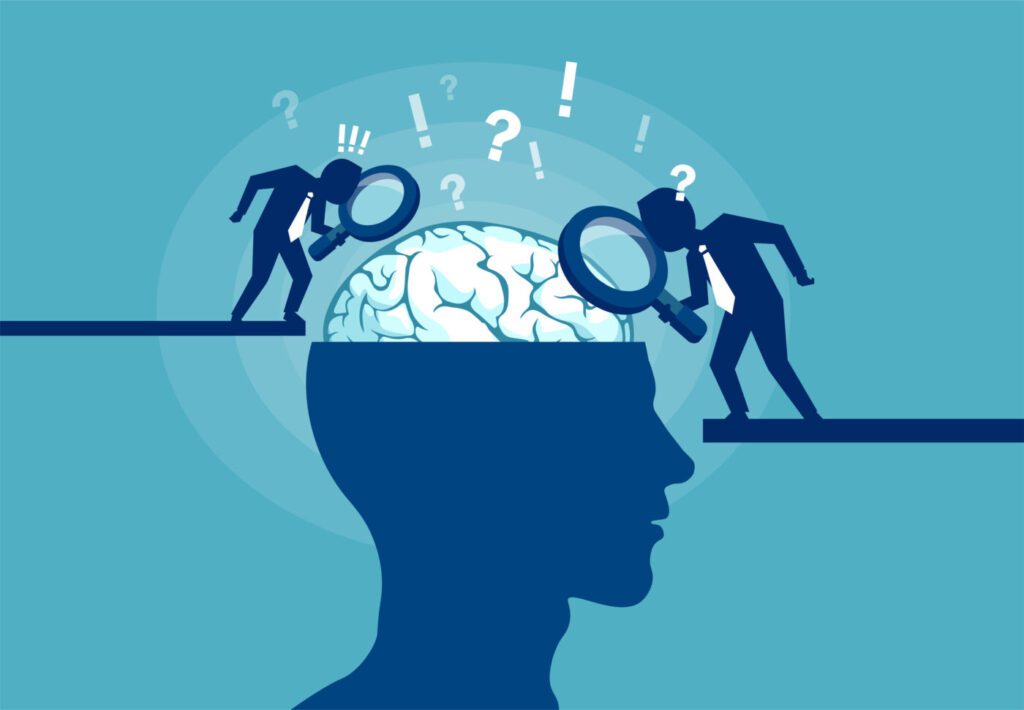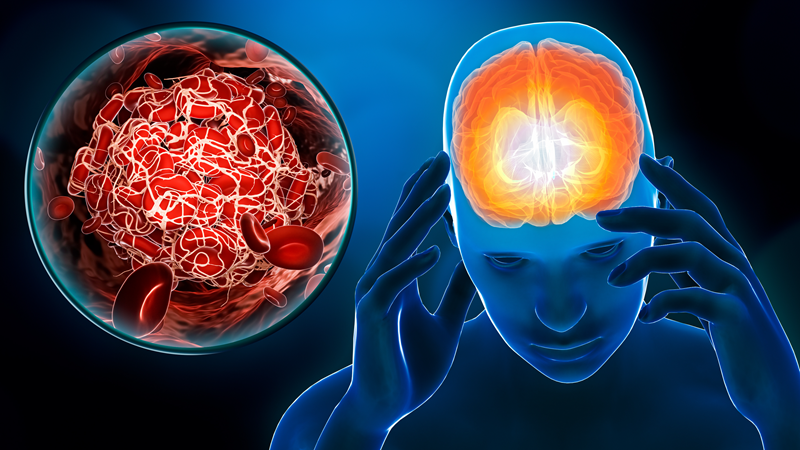
Psychedelics such as LSD, psilocybin, DMT, ayahausca and others have been shown to have clinical efficacy in the treatment of depression, anxiety, addiction, PTSD and other psychiatric disorders. They also show promise as a potential treatment for neurodegenerative diseases such as Alzheimer’s disease, dementia and Parkinson’s disease, as well as stroke recovery and neuropathic pain.
What are psychedelics?
Psychedelics include LSD, psilocybin and DMT.

LSD (Lysergic acid diethylamide) is derived from ergot, a fungi that infects grain. 2,5-Dimethoxy-4-iodoamphetamine (DOI) is a synthetic psychedelic substance often compared to and used to model the effects of LSD.
Psilocybin is found in “magic mushrooms”, specific fungi such as psilocybe cubensis. Psilocybin is degraded quickly into psilocin after ingestion, the bioactive compound.
DMT (N,N-Dimethyltryptamine) is found in ayahuasca, a South American brewed drink that consists of many plants, including Psychotria viribis (which contains the DMT). Ayahuasca also contains non-psychedelic beta-alkaloids that inhibit monoamine oxidase A, and these compounds allow DMT to pass through the digestive tract and reach the brain unmetabolized. 5MeO-DMT is an analog of DMT, and is found in a variety of plant species, as well as the venom of the Colorado River toad.
The evidence is clear: Psychedelics and clinical studies

LSD, ayahuasca and psilocybin have been shown to improve depressive, anxiolytic and addictive symptoms in patients. Remarkably, some studies have shown that these effects persist for weeks to almost 6 months after just one to two doses. At the moment, many patients with psychiatric conditions have to take medication for the rest of their life, and these treatments often have serious side effects. Psychedelics could offer a new solution.
There is a wealth of clinical evidence showing psilocybin’s significant effectiveness in treating depression, with early studies showing that psilocybin relieved symptoms for up to a month. But in an astonishing new study published earlier this year, researchers showed that the anti-depressant effects of psilocybin treatment may last for at least a year in some patients. Research recently said, “Psilocybin not only produces significant and immediate effects, it also has a long duration, which suggests that it may be a uniquely useful new treatment for depression. Compared to standard antidepressants, which must be taken for long stretches of time, psilocybin has the potential to enduringly relieve the symptoms of depression with one or two treatments.”
Serotonin: More than just the “happy hormone”
LSD exhibits affinity for 5-HT1A/D, 2A/B/C, and 5-HT6 as well as the dopamine D1 and D2 receptors and the α-adrenergic receptors. Both psilocin and psilocybin exhibit affinity for a range of serotonin receptors such as 5-HT1A/B/D/E, 2A/B, 5, 6, 7. DMT and its analog 5MeO-DMT are agonists of 5-HT1A/D, 2A, and 5-HT6 receptors.
All of these psychedelics activate the 5-HT2A receptor, a serotonin receptor. Findings from many studies over the years have shown that many of the effects psychedelics have on the brain are mediated by effector pathways induced by 5-HT2A describing a unifying mechanism of action.
So, what is the 5-HT2A receptor? The 5-HT2A receptor is a G-protein coupled receptor and is widely distributed in the central nervous system. They are especially dense in brain regions essential for learning and cognition, specifically the pre-frontal cortex. Serotonin has a reputation in pop culture as the “happy hormone”, but 5-HT2A receptor activation and inhibition has been shown to have diverse behavioural, physiological, and psychological effects.
Psychedelic activation of the 5-HT2A receptor has been comprehensively studied, and the figure below gives an overview of the different downstream effects of psychedelic-induced 5-HT2A receptor activation. Notably, the activation of these downstream signalling pathways can influence gene expression. These genes can then go on to influence synaptic plasticity and brain neurochemistry, and these effects are often long-term. These induced long-term changes likely underlie the therapeutic efficacy of a single administration of psychedelics to achieve lasting effects, as seen in clinical studies.

One dose is all you need: Genetic changes induced by psychedelics
Psychedelics have been shown to produce overlapping genetic changes in many different regions of the brain, and these changes have been shown to last for months after a single dose. Immediate early genes (IEGs) are the most well-studied gene expression changes, with transcription changes observed within minutes of 5-HT2A stimulation. The first IEG identified was c-Fos, which was shown to be induced by DOI.
So, what is c-Fos? C-Fos is a transcription factor involved in oncogenic progression, but in the brain it’s associated with many neural and behavioural responses, and is often used as a marker of neuronal activity. Decreases in c-Fos have been observed in age-related changes in neuronal function and plasticity, and c-Fos knock-out studies in mice have been shown to lead to behavioural changes such as learning impairment.
In 1993, researchers observed increased c-Fos expression in the brains of rats, with expression peaking 3 hours after DOI administration. This study also showed that this gene-expression change was mediated via the 5-HT2A receptor, as the antagonist ritanserin eliminated the observed increase in c-Fos expression. This finding was reaffirmed by the same team of researchers in 1998, who also demonstrated a dose-response relationship between levels of c-Fos and DOI, and a high correlation between levels of c-Fos staining and 5-HT2A receptor-ligand binding sites. In 1996, another team of researchers reported increases in mRNA levels of c-Fos following DOI administration in the cortex and hippocampus, and all changes were again abolished by a 5-HT2A receptor antagonist, ketanserin.
These findings were again reaffirmed in 1999, when LSD was shown to induce c-Fos expression, and mRNA levels were increased in the brains of rats. Another study in 2000, showed that the pattern of c-Fos expression induced by LSD mimicked the pattern seen with DOI administration. In 2002, induction of c-Fos protein following LSD administration was shown to be attenuated by a selective 5-HT2A receptor antagonist MDL100907, further demonstrating that c-Fos induction is mediated via the 5-HT2A receptor. A later study in 2002v also showed that a lower dose of LSD (0.16mg/kg compared with 0.5mg/kg in previous studies) was still able to induce c-Fos expression.

Other types IEGs which aren’t transcription factors include BDNF, a neurotrophin involved in neuronal development, synaptic plasticity, and changes in dendritic morphology. BDNF mRNA levels were first shown to increase in a dose-dependent manner in rats following DOI administration in 1997, and again these effects were eliminated by ketanserin as well as MDL100907. In recent studies, such as this LSD study in 2021, show that low doses of LSD acutely increase BDNF blood plasma levels in humans. Psychedelic-induced upregulation of BDNF does provide one potential pathway by which psychedelics influence neural plasticity, as BDNF has a role in the potentiation of active synapses and has been shown to mediate synaptogenesis and promote neuroplasticity.
Another IEG is arc (activity-regulated cytoskeleton protein) which is an effector gene that has an affinity for neuronal dendrites, and is shuttled and transcribed at active synapses. Arc also modulates the development of late long-term potentiation, which is critical to the formation of long-term memories. In a study in 2000, researchers showed that DOI administration led to increased expression of arc in a dose-dependent fashion, and again, the effect was completely abolished upon administration of ketanserin. In 2004, another study reaffirmed these findings and also showed that arc expression and c-Fos expression largely overlapped, suggesting that the same cells were producing these two IEGs. And in 2013, another study showed that arc induction following DOI was reduced following induced-loss of BDNF expression, suggesting a relationship between these two IEGs. Arc provides another pathway for psychedelics to promote neuroplasticity, as arc regulates synaptic strength, and according to a review in Cell is involved in “essentially every known form of synaptic plasticity.”

Genomics and Psychedelics: Recent evidence
More recent studies leveraging advances in genomics have studied the transcriptional response to psychedelics in a more unbiased manner. A series of microarray studies, as well as in vitro and in vivo transcriptomics studies, have identified several more genes upregulated by LSD. The general functions of the genes induced by LSD were varied, but one common thread connected them all: They all had a known effect on synaptic plasticity. The genes nor1 and sgk have been shown to be involved in long-term potentiation in the hippocampus. Ania3 is a splice variant in the homer1 gene family which encode proteins in the synapse and is involved in mGluR-mediated plasticity. C/EBP-b is known to effect synaptic strength and the formation of memories. Egr genes regulate synaptic plasticity related to learning and memory, and in 2005 a study showed how Egr1 and 3 directly regulate arc. A 2021 study in rats also showed that psilocybin administration induced expression of IEG genes including c-Fos, Sgk1 and Egr2, among others.
A 2021 RNA-seq study by Charles Nichols, who we interviewed last year, described LSD-induced rewiring of gene co-expression networks in rats. Analysis of RNA-seq data showed that genes related to neuroplasticity and transmission were upregulated, including BDNF. They also showed that prolonged LSD exposure has a long-term effect on epigenetic machinery, and genes involved in “covalent chromatin modification” and “histone modification” were highly enriched, including the gene Tet1, which is involved in the erasure of DNA methylation.
Using computational analysis, researchers built gene-coexpression networks based on their RNA-seq data, and investigated regulatory relationships between genes before and after LSD treatment. They identified several clusters of genes, which were involved in the regulation of chromatin organisation, vesicle-mediated transport in synapses, and cell-cell adhesion. They then further investigated the transcriptional entropy of these gene networks to measure how LSD changes these networks and found that LSD treatment increased the plasticity of these networks, making them more complex and less centralised. The increased plasticity of these networks together with the epigenetic alterations caused by LSD treatment could explain the long-term impact of psychedelics on the “wiring” of the brain.

Rewiring the brain: Bringing plasticity back
As we’ve already discussed, psychedelics induce changes in processes that persist beyond their initial administration, sometimes for up to 6 months. This suggests a biological adaptation, such as neural plasticity. Neural plasticity describes the brain’s ability to change connections between neurons, and throughout development neural plasticity and neural stability are critical processes.
For motor function or visual perception, neural networks become stable early on. For other processes, such as those in the prefrontal cortex regulating cognition, networks may remain plastic throughout life. Mediating this process and facilitating the rewiring of certain networks may be possible through the use of psychedelics.
We’ve already covered how changes in gene expression induced by psychedelic activation of the 5-HT2A receptor can influence neural plasticity. The overwhelming evidence that psychedelics induce neuroplasticity has led to them being characterised as “Psychoplastogens”: defined as “a relatively new class of fast-acting therapeutics, capable of rapidly promoting structural and functional neural plasticity.”

In a 2016 study, researchers showed in in vitro cultured human cortical neurons, DMT has a neuroprotective effect. These cells were put under hypoxic stress and showed that DMT significantly increases the survival of these cells. In another in vitro study from 2017, researchers explored proteome changes after administration of 5-MeO-DMT to human cerebral organoids. In silico analysis revealed that 5-MeO-DMT modulated proteins in pathways associated with LTP, formation of dendritic spines, cellular protrusion formation, and cytoskeletal reorganisation.
In a study from 2018, researchers showed that DMT, LSD and DOI increase dendritic complexity, promote dendritic spine growth, and stimulate synaptogenesis. Using ketanserin, they also showed these changes were mediated by the 5-HT2A signalling pathways. Neuritogenesis describes the large-scale evolution of new neuronal processes, and in this study, LSD was found to be the most potent stimulator of this process, inducing huge increases in the number of dendritic branches and length of projections.
A 2018 study showed that a single dose of 5-MeO-DMT induced neurogenesis and the development of dendritic spines in neurons . Researchers observed the proliferation of neuronal progenitor cells, and the survival of newborn neurons were increased in the ventral hippocampus, which is a region involved in emotion and stress. Furthermore, the dendritic spines which were stimulated by 5-MeO-DMT grew more quickly toward a mature neuron, developing more complex morphology.
A 2020 study investigated the neurogenic effect of DMT and showed that DMT activated the subgranular zone of the dentate gyrus of the hippocampus . This region of the brain is known as the main adult neurogenic centre, and researchers observed DMT promoted newly generated neurons, astrocytes and oligodendrocytes in this zone. The study also showed that treated with DMT performed better in memory tests, suggesting that DMT-induced neurogenesis may improve memory. A 2020 metabolomics study showed Ayahuasca treatment increased the survival rate of human neuroblastoma cells under neurotoxic stress.
Imaging studies have also shown that psychedelics can alter network connectivity. Psilocybin and LSD in particular have been studied in many recent studies. In a 2016 study, researchers used 3 different brain imaging techniques to reveal changes in brain activity and functional connectivity as seen in the figure below. LSD facilitated the disintegration of default connections, restoring plasticity to “permanent” stable networks. LSD also induced hyperconnectivity between different brain regions allowing centres that don’t normally communicate to interact with each other. Another 2018 study showed that LSD increased sensory-somatomotor connectivity with different regions of the brain, including the thalamus, and these effects were eliminated by ketanserin. A 2021 study showed that psilocybin induced changes in brain network integrity and segregation. Using functional magnetic resonance imaging, researchers observed a dose-dependent relationship between psilocybin and measures of network integrity and segregation. They found that the executive control network and dorsal attention network desegregate and have increased connectivity with other networks.

Not just mental health: Alzheimer’s Disease and dementia
The use of psychedelics as a potential treatment for mental health conditions has been comprehensively studied. But a new frontier is emerging, as researchers are starting to explore psychedelics as a treatment for other neurological diseases.
In a 2021 review article, scientists assessed the clinical evidence for psychedelics in treating Alzheimer’s Disease and dementia, and came up with some interesting insights. Firstly the 5-HT2A receptor is found in high concentrations in regions of the brain vulnerable to dementia. Psychedelic-induced neuroplasticity and neurogenesis via the 5-HT2A receptor in this region could theoretically help protect this region from degeneration, and potentially even rewire connections to improve cognition.
Secondly, many imaging studies have shown the effect of psychedelics on the reorganisation of neural networks. Alongside results from surveys, where individuals reported that psychedelic-treatment increased cognition and memory retention, this suggests that perhaps psychedelics could ameliorate dysfunctional circuits in cognitive impairment in dementia.
Thirdly, this review highlighted the anti-inflammatory effect of psychedelics. Psychedelics have been shown to have potent anti-inflammatory properties, and their affinity for the 5-HT2A receptor means this anti-inflammatory effect may be specifically targeted to the brain. As all known genetic and environmental risk factors in Alzheimer’s Disease are associated with inflammation, psychedelics could treat AD in this way.
Another review article from 2021, published in the Journal of Neurochemistry, further assesses the potential of psychedelics for the treatment of neurodegenerative disorders. Psychedelic-induced neurotrophic gene expression, such as BDNF, has the potential to rescue the degeneration of neurons occurring in these diseases. This suggests that psychedelics could not only have a protective effect, but they could potentially be curative, reversing neurodegeneration by stimulating neurogenesis and neuroplasticity. Moreover, this review reaffirms the central role of the 5-HT2A receptor in neuronal health and how serotonergic receptors have been shown to be dysregulated in Alzheimer’s Disease. This review also highlights the potential for psychedelics to improve the depressive and cognitive deficits symptoms of neurodegenerative diseases. In fact a clinical trial for the use of psilocybin to treat depression in people with Alzheimer’s disease.




